Page 43 of 878
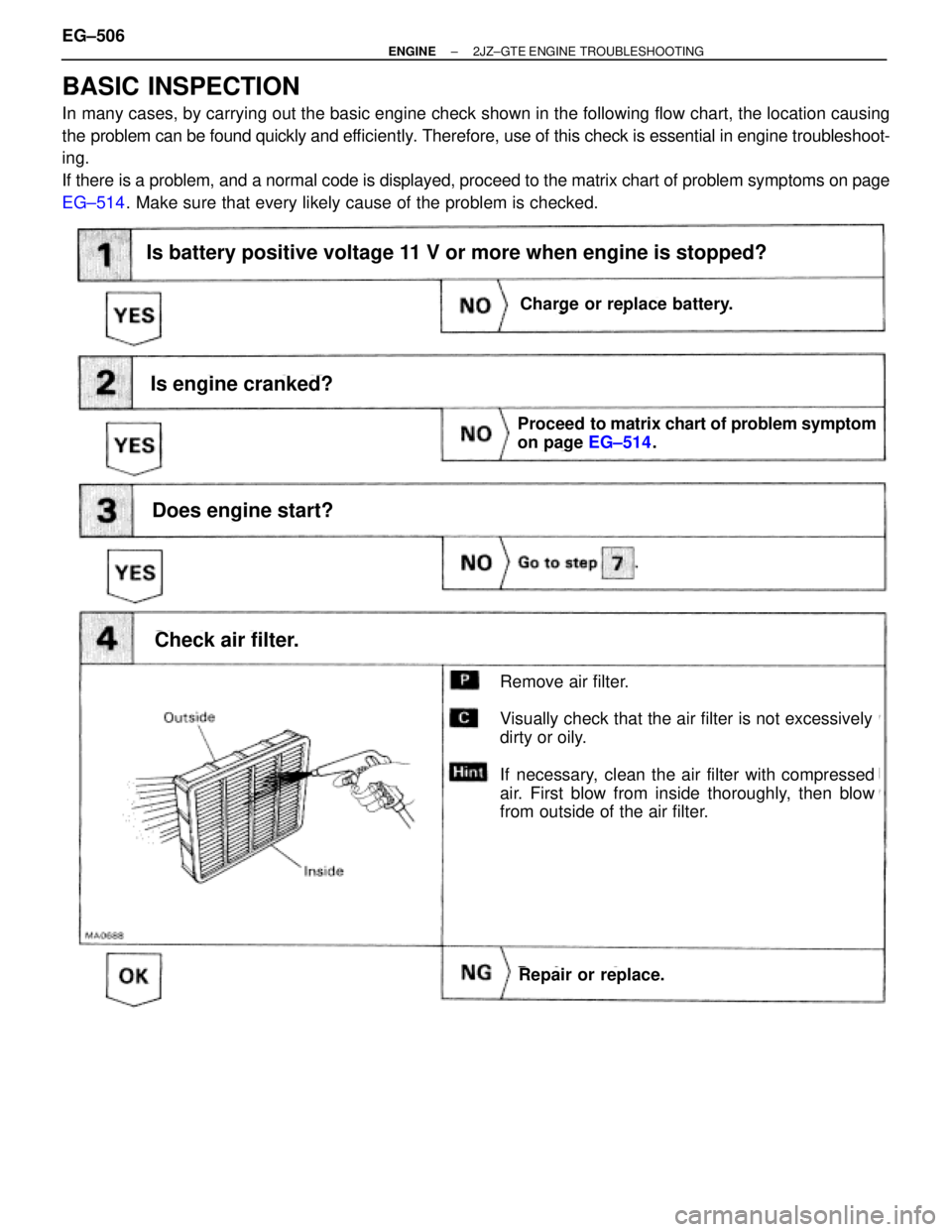
BASIC INSPECTION
In many cases, by carrying out the basic engine check shown in the following flow chart, the location causing
the problem can be found quickly and efficiently. Therefore, use of this check is essential in engine troubleshoot-
ing.
If there is a problem, and a normal code is displayed, proceed to the matrix chart of problem symptoms on page
EG±514. Make sure that every likely cause of the problem is checked.
Is battery positive voltage 11 V or more when engine is stopped?
Is engine cranked?
Does engine start?
Check air filter.
Charge or replace battery.
Proceed to matrix chart of problem symptom
on page EG±514.
Repair or replace.
Remove air filter.
Visually check that the air filter is not excessively
dirty or oily.
If necessary, clean the air filter with compressed
air. First blow from inside thoroughly, then blow
from outside of the air filter.
Charge or replace battery.
Is battery positive voltage 11 V or more when engine is stopped?
EG±506± ENGINE2JZ±GTE ENGINE TROUBLESHOOTING
Page 44 of 878
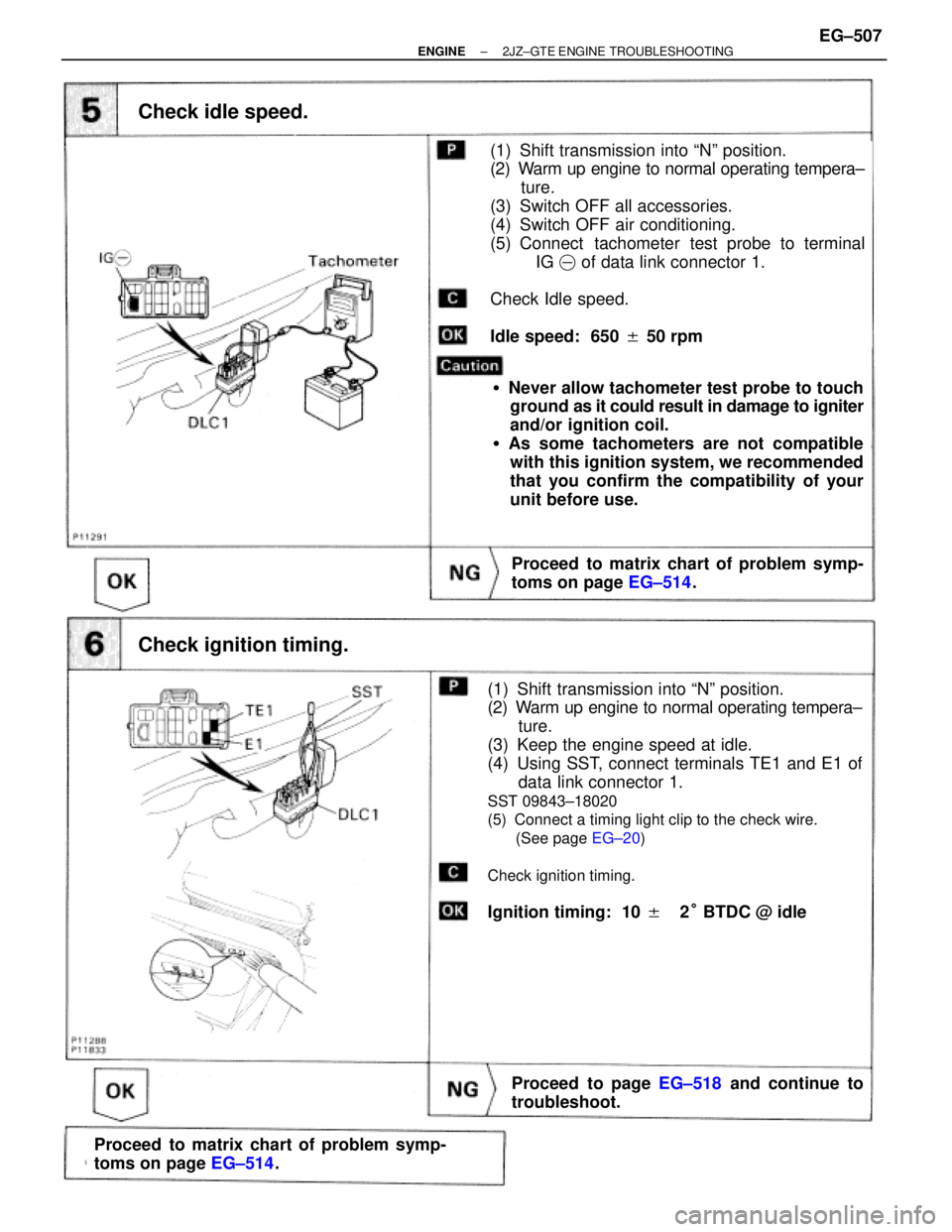
(See page EG±20)
Check idle speed.
Proceed to matrix chart of problem symp-
toms on page EG±514.
(1) Shift transmission into ªNº position.
(2) Warm up engine to normal operating tempera±
ture.
(3) Switch OFF all accessories.
(4) Switch OFF air conditioning.
(5) Connect tachometer test probe to terminal
IG� of data link connector 1.
Check Idle speed.
Idle speed: 650 � 50 rpm
�Never allow tachometer test probe to touch
ground as it could result in damage to igniter
and/or ignition coil.
�As some tachometers are not compatible
with this ignition system, we recommended
that you confirm the compatibility of your
unit before use.
Check ignition timing.
(1) Shift transmission into ªNº position.
(2) Warm up engine to normal operating tempera±
ture.
(3) Keep the engine speed at idle.
(4) Using SST, connect terminals TE1 and E1 of
data link connector 1.
SST 09843±18020
(5) Connect a timing light clip to the check wire.
(See page EG±20)
Check ignition timing.
Ignition timing: 10 ��2° BTDC @ idle
Proceed to matrix chart of problem symp-
toms on page EG±514.
Proceed to page EG±518 and continue to
troubleshoot.
± ENGINE2JZ±GTE ENGINE TROUBLESHOOTINGEG±507
Page 45 of 878
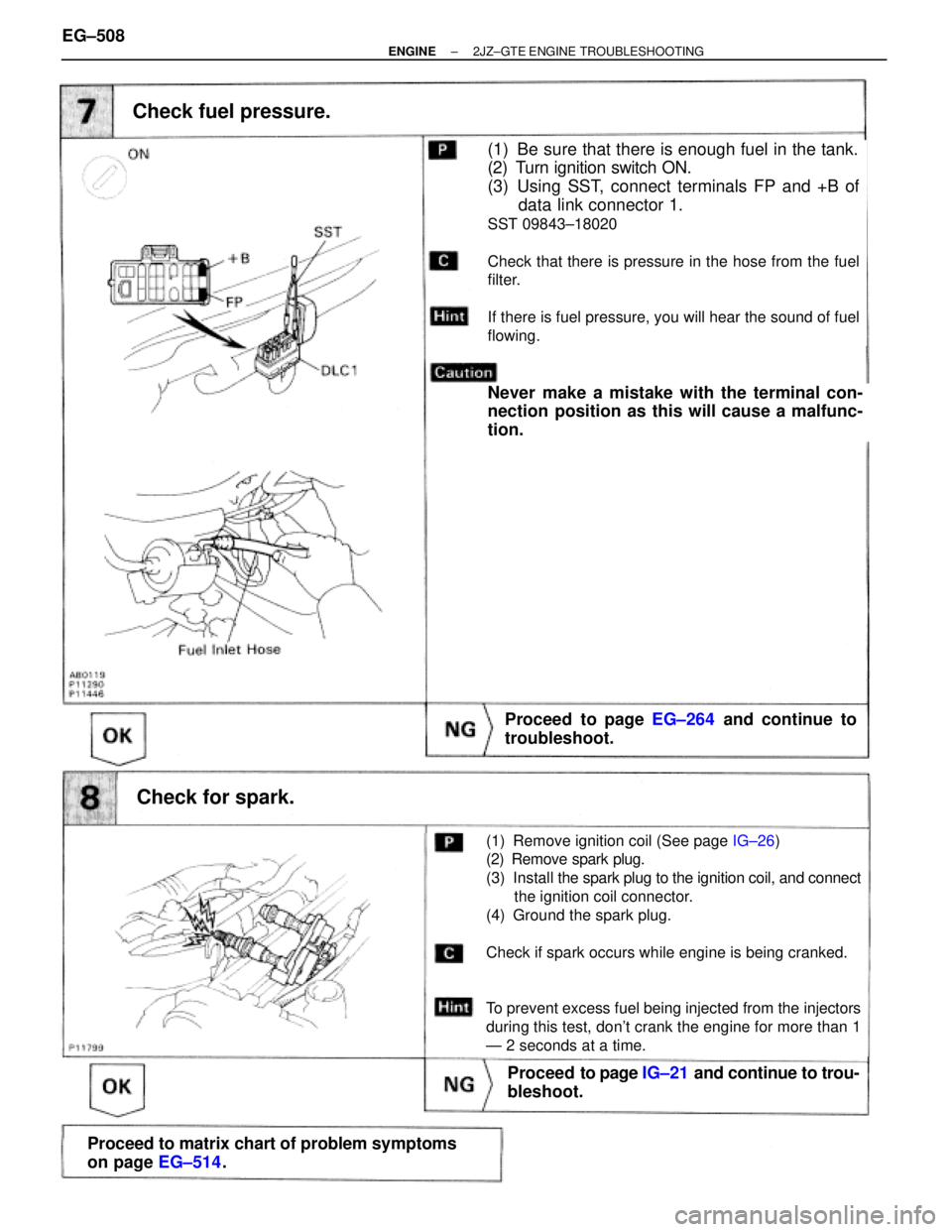
(See page
IG±26)
Check fuel pressure.
Proceed to page EG±264 and continue to
troubleshoot.
(1) Be sure that there is enough fuel in the tank.
(2) Turn ignition switch ON.
(3) Using SST, connect terminals FP and +B of
data link connector 1.
SST 09843±18020
Check that there is pressure in the hose from the fuel
filter.
If there is fuel pressure, you will hear the sound of fuel
flowing.
Never make a mistake with the terminal con-
nection position as this will cause a malfunc-
tion.
Check for spark.
Proceed to page IG±21 and continue to trou-
bleshoot.
Proceed to matrix chart of problem symptoms
on page EG±514.
(1) Remove ignition coil (See page IG±26)
(2) Remove spark plug.
(3) Install the spark plug to the ignition coil, and connect
the ignition coil connector.
(4) Ground the spark plug.
Check if spark occurs while engine is being cranked.
To prevent excess fuel being injected from the injectors
during this test, don't crank the engine for more than 1
Ð 2 seconds at a time.
EG±508± ENGINE2JZ±GTE ENGINE TROUBLESHOOTING
Page 47 of 878
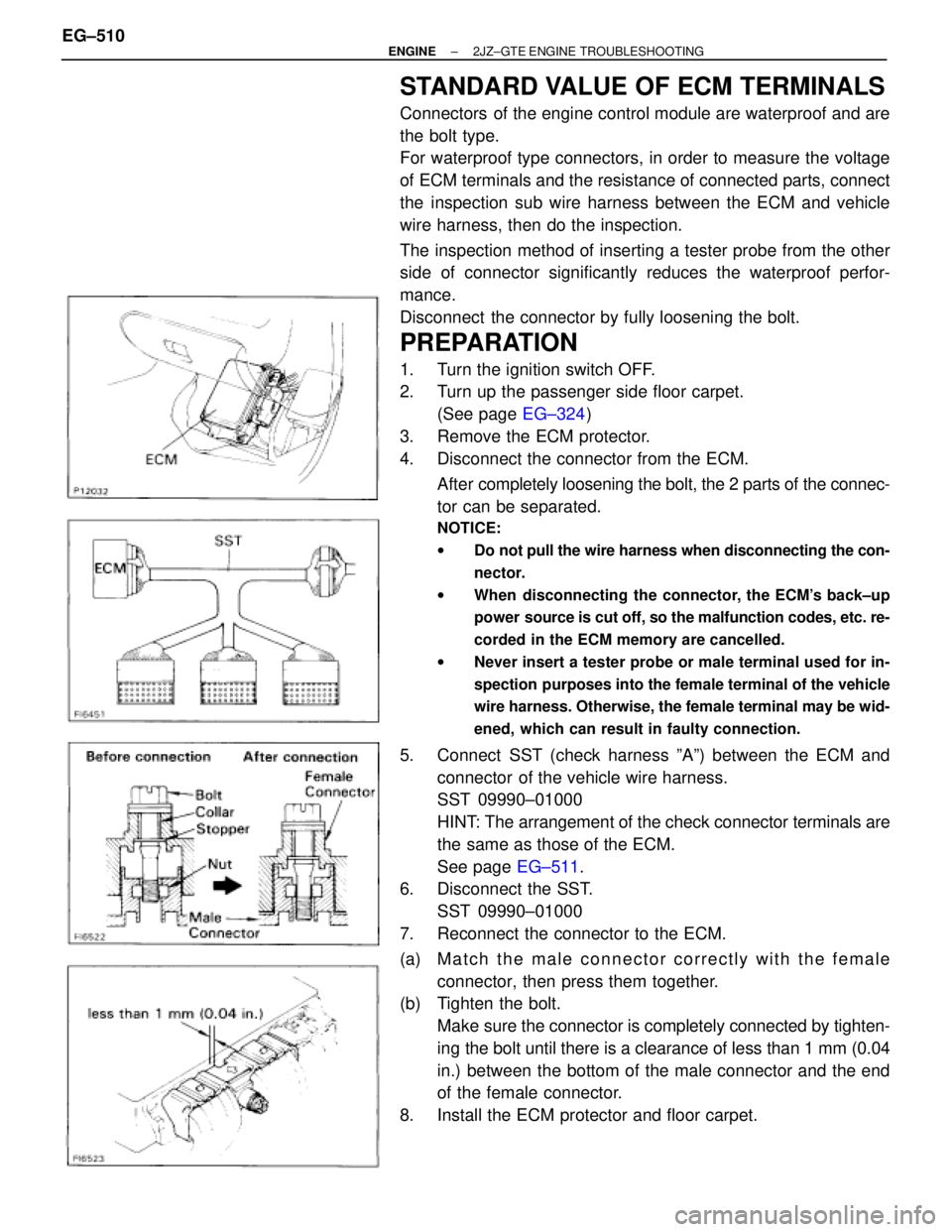
STANDARD VALUE OF ECM TERMINALS
Connectors of the engine control module are waterproof and are
the bolt type.
For waterproof type connectors, in order to measure the voltage
of ECM terminals and the resistance of connected parts, connect
the inspection sub wire harness between the ECM and vehicle
wire harness, then do the inspection.
The inspection method of inserting a tester probe from the other
side of connector significantly reduces the waterproof perfor-
mance.
Disconnect the connector by fully loosening the bolt.
PREPARATION
1. Turn the ignition switch OFF.
2. Turn up the passenger side floor carpet.
(See page EG±324)
3. Remove the ECM protector.
4. Disconnect the connector from the ECM.
After completely loosening the bolt, the 2 parts of the connec-
tor can be separated.
NOTICE:
wDo not pull the wire harness when disconnecting the con-
nector.
wWhen disconnecting the connector, the ECM's back±up
power source is cut off, so the malfunction codes, etc. re-
corded in the ECM memory are cancelled.
wNever insert a tester probe or male terminal used for in-
spection purposes into the female terminal of the vehicle
wire harness. Otherwise, the female terminal may be wid-
ened, which can result in faulty connection.
5. Connect SST (check harness ºAº) between the ECM and
connector of the vehicle wire harness.
SST 09990±01000
HINT: The arrangement of the check connector terminals are
the same as those of the ECM.
See page EG±511.
6. Disconnect the SST.
SST 09990±01000
7. Reconnect the connector to the ECM.
(a) M a t c h t h e m a l e connector correctly with the female
connector, then press them together.
(b) Tighten the bolt.
Make sure the connector is completely connected by tighten-
ing the bolt until there is a clearance of less than 1 mm (0.04
in.) between the bottom of the male connector and the end
of the female connector.
8. Install the ECM protector and floor carpet. EG±510
± ENGINE2JZ±GTE ENGINE TROUBLESHOOTING
Page 51 of 878
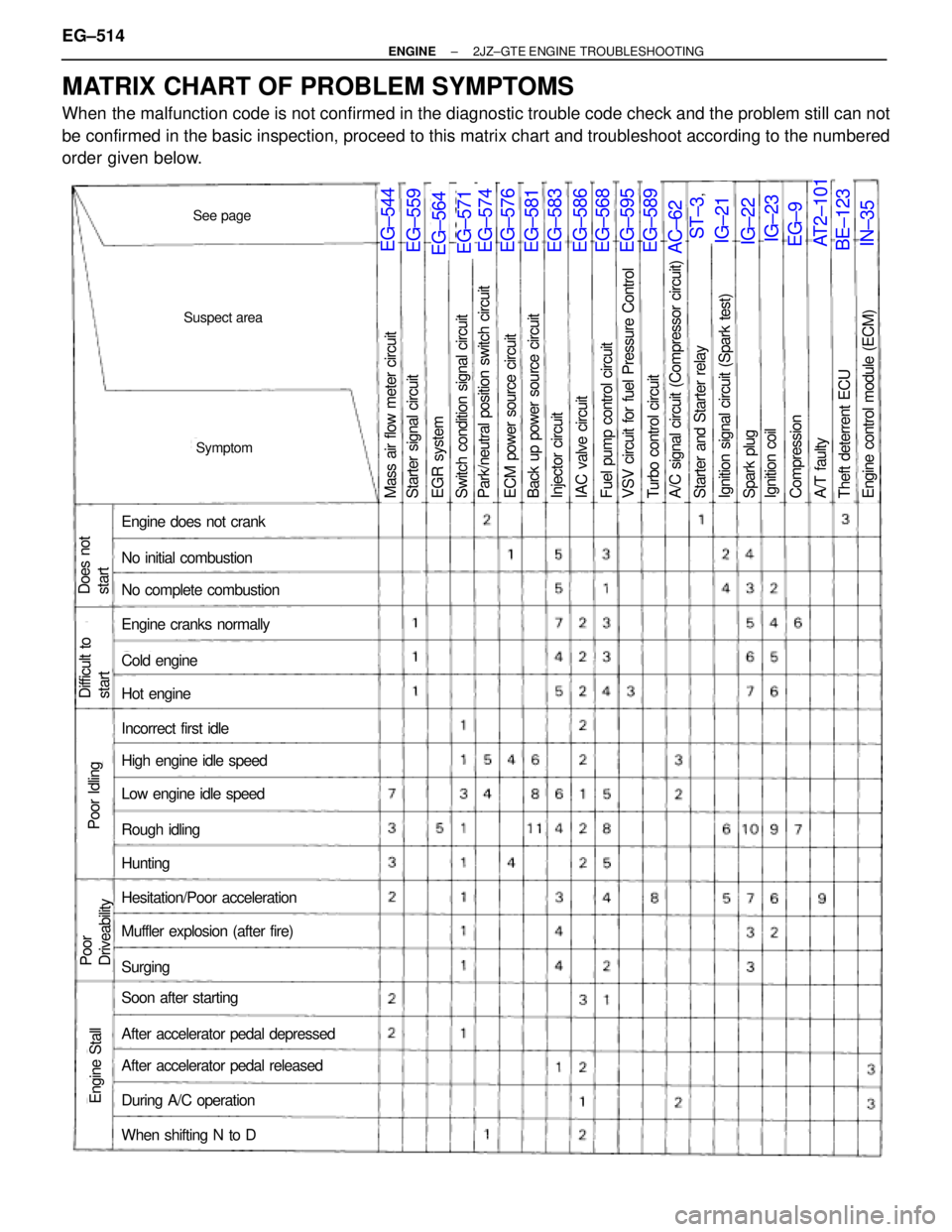
Suspect area
See page
Symptom
Engine does not crank
No initial combustion
No complete combustion
Engine cranks normally
Cold engine
Hot engine
Incorrect first idle
High engine idle speed
Low engine idle speed
Rough idling
Hunting
Hesitation/Poor acceleration
Muffler explosion (after fire)
Surging
Soon after starting
After accelerator pedal depressed
After accelerator pedal released
During A/C operation
When shifting N to D
Does not
start
Difficult to
start
Poor Idling
Engine Stall
Poor
Driveability
Back up power source circuitECM power source circuitPark/neutral position switch circuitSwitch condition signal circuitEGR systemStarter signal circuitMass air flow meter circuitInjector circuitIAC valve circuitFuel pump control circuitA/C signal circuit (Compressor circuit)Turbo control circuitVSV circuit for fuel Pressure ControlCompressionSpark plugIgnition signal circuit (Spark test)Starter and Starter relayIgnition coilEngine control module (ECM)Theft deterrent ECUA/T faulty
EG±544EG±559EG±564EG±571EG±574EG±576EG±581EG±583EG±586EG±568EG±595EG±589AC±62ST±3
,
12
IG±21IG±23IG±22EG±9AT2±101BE±123IN±35
MATRIX CHART OF PROBLEM SYMPTOMS
When the malfunction code is not confirmed in the diagnostic trouble code check and the problem still can not
be confirmed in the basic inspection, proceed to this matrix chart and troubleshoot according to the numbered
order given below. EG±514
± ENGINE2JZ±GTE ENGINE TROUBLESHOOTING
Page 53 of 878
INSPECTION PROCEDURE
(See page IG±30).
Check crankshaft position sensor, camshaft position sensors No.1, No.2.
For crankshaft position sensor, remove crankshaft posi-
tion sensor (See page IG±30).
For camshaft position sensor No.1, No.2, disconnect
camshaft position sensor No.1 No.2 connectors.
Measure resistance of crankshaft position sensor, cam-
shaft position sensor No.1 and No.2.
Camshaft
Position Sensor
No.1 and No.2
Camshaft
Position
Sensor
ªColdº is from Ð 10°C (14°F) to 50°C (122°F) and ªHotº
is from 50°C (122°F) to 100°C (212°F).
EG±516± ENGINE2JZ±GTE ENGINE TROUBLESHOOTING
Page 54 of 878
Check for open and short in harness and connector between engine control
module and each sensor (See page IN±30).
�During cranking or idling, check waveforms between
terminals G1, G2 and G1 �, G2 �, NE and NE � of
engine control module.
HINT: The correct waveforms are as shown.
Inspect sensor installation and teeth of timing rotor.
INSPECTION USING OSCILLOSCOPE
Replace crankshaft position sensor, camshaft
position sensor No.1, No.2.
Tighten the sensor. Replace timing rotor (Intake
camshaft, crankshaft timing pulley).
Check and replace engine control module.
Repair or replace harness or connector.
± ENGINE2JZ±GTE ENGINE TROUBLESHOOTINGEG±517
Page 55 of 878
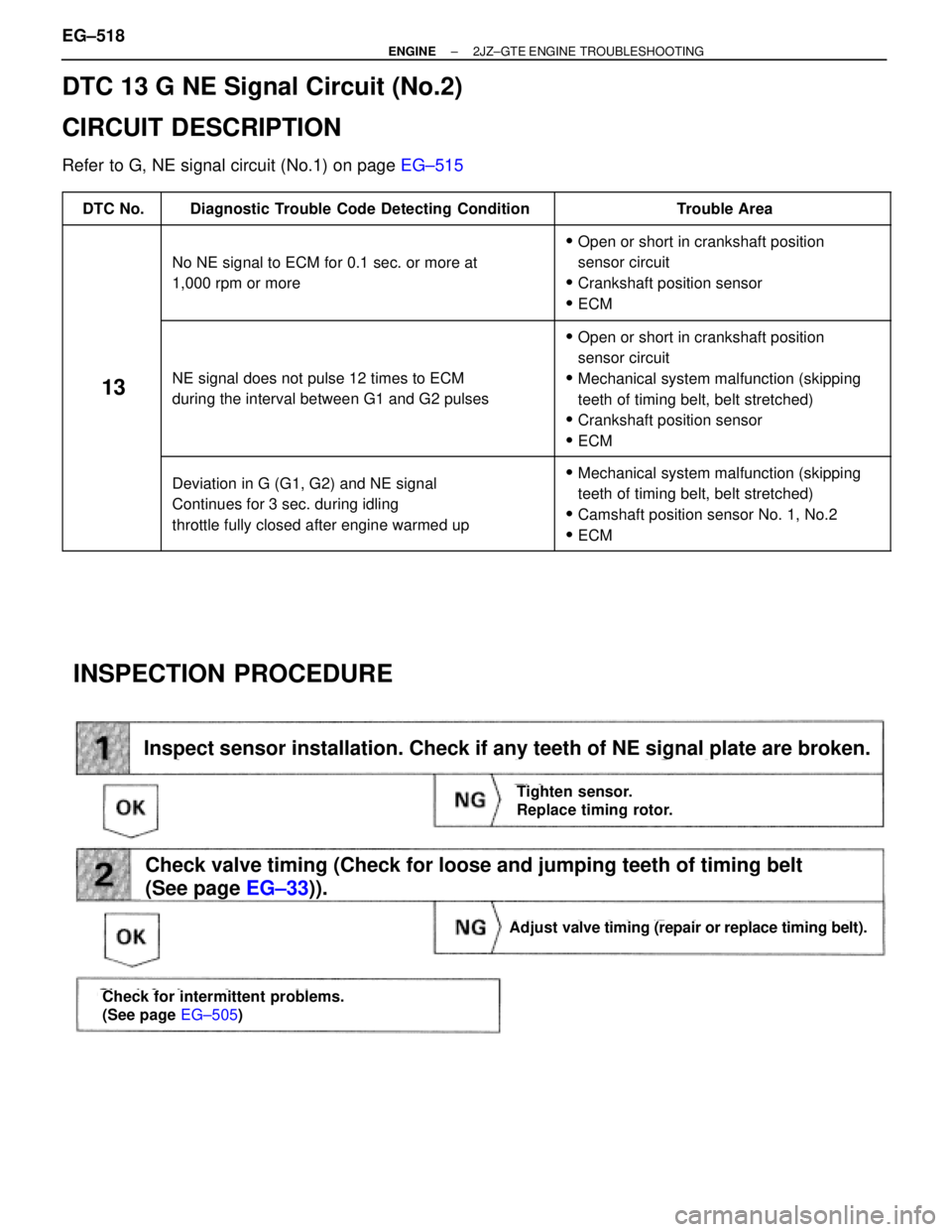
DTC 13 G NE Signal Circuit (No.2)
CIRCUIT DESCRIPTION
Refer to G, NE signal circuit (No.1) on page EG±515
����� �����DTC No.������������������ ������������������Diagnostic Trouble Code Detecting Condition��������������� ���������������Trouble Area
����� �
���� �
���� �
���� �����
������������������ �
����������������� �
����������������� �
����������������� ������������������
No NE signal to ECM for 0.1 sec. or more at
1,000 rpm or more
��������������� �
�������������� �
�������������� �
�������������� ���������������
�Open or short in crankshaft position
sensor circuit
�Crankshaft position sensor
�ECM
����� �
���� �
���� �
���� �
���� �
���� �����
13
������������������ �
����������������� �
����������������� �
����������������� �
����������������� �
����������������� ������������������
NE signal does not pulse 12 times to ECM
during the interval between G1 and G2 pulses
��������������� �
�������������� �
�������������� �
�������������� �
�������������� �
�������������� ���������������
�Open or short in crankshaft position
sensor circuit
�Mechanical system malfunction (skipping
teeth of timing belt, belt stretched)
�Crankshaft position sensor
�ECM
����� �
���� �
���� �
���� �����
������������������ �
����������������� �
����������������� �
����������������� ������������������
Deviation in G (G1, G2) and NE signal
Continues for 3 sec. during idling
throttle fully closed after engine warmed up��������������� �
�������������� �
�������������� �
�������������� ���������������
�Mechanical system malfunction (skipping
teeth of timing belt, belt stretched)
�Camshaft position sensor No. 1, No.2
�ECM
INSPECTION PROCEDURE
Inspect sensor installation. Check if any teeth of NE signal plate are broken.
Tighten sensor.
Replace timing rotor.
Adjust valve timing (repair or replace timing belt).
Check valve timing (Check for loose and jumping teeth of timing belt
(See page EG±33)).
Check for intermittent problems.
(See page EG±505)
EG±518± ENGINE2JZ±GTE ENGINE TROUBLESHOOTING